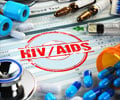Regimens to treat HIV infection that are based on a non-nucleoside reverse transcriptase inhibitor (NNRTI) are at least as effective as treatment with a protease inhibitor but…
Regimens to treat HIV infection that are based on a non-nucleoside reverse transcriptase inhibitor (NNRTI) are at least as effective as treatment with a protease inhibitor but require patients to take fewer pills each day, according to a new study funded in part by HHS’ Agency for Healthcare Research and Quality.
The study, published in the October 28 online issue of the Lancet, found that disease progression was similar for both regimens, but NNRTI-based treatment appeared more effective at decreasing the amount of virus in the blood. The number of patients who stopped treatment because of adverse events was similar for both medications.The new study is the first to review all published research that directly compares the two classes of antiretroviral drugs used in highly active antiretroviral therapy (HAART). NNRTI-based regimens were found to be up to 60 percent more likely to suppress the amount of virus in patients’ blood than protease inhibitor-based regimens. The percentage of patients who died or experienced disease progression were similar between the two treatments, and the number of patients who stopped taking the medications because of side effects or adverse events was also similar.
While some protease inhibitors require four doses each day, one NNRTI, efavirenz, can be taken in one daily dose. This convenience could increase the likelihood that patients will adhere to their HIV regimens.
Publication of the study follows the July 12 approval by the Food and Drug Administration of the first once-a-day medication to treat HIV. The drug contains emtricitabine and tenofovir, two nucleoside reverse transcriptase inhibitors, plus efavirenz. The components of the drug were previously available, but it is anticipated that the new combined formulation will simplify treatment and improve compliance.
"A simpler regimen offers the potential of improved adherence and better patient outcomes. Combined with the approval of new dosage formulations, this information could improve the management of patients in this country and in regions of the world where access to medical care and treatment compliance can be challenging," said AHRQ Director Carolyn M. Clancy, M.D. “These findings highlight the need for additional research that evaluates the extent to which improvements in markers of a disease, such a viral suppression, lead to improved clinical outcomes.”
The Centers for Disease Control and Prevention estimates that between 1 million and 1.2 million people in the United States are living with HIV, and at least 40,000 new infections occur each year. Worldwide, approximately 40 million individuals are infected with the virus.
Advertisement
Dramatic decreases in the rate of HIV-related illnesses and deaths have occurred since the introduction of HAART therapy in which three or more antiretroviral agents are used. However, until now, comparisons of head-to-head trials were not available to support selection of a protease inhibitor or an NNRTI as part of that combination therapy. Researchers concluded that earlier analyses may be unreliable because their results differed dramatically from the analysis of head-to-head trials, even after excluding patients who had previously received HIV therapy and those who had received older NNRTIs, such as delaviridine, that are now used infrequently because they are less effective than newer NNRTIs. Prior antiretroviral treatment can cause drug resistance and treatment failure.
Advertisement











